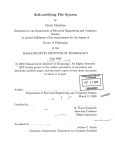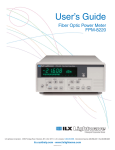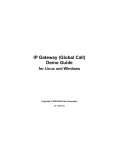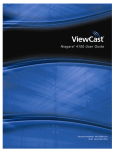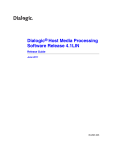Download Dialogic Multimedia File Conversion Tools User Guide
Transcript
Dialogic® Multimedia File
Conversion Tools
User Guide
February 2010
05-2453-009
About This Publication
Purpose
This document provides information on how to use the off-line multimedia file conversion
tools (also referred to as utilities). These tools can be used to convert multimedia file data
between industry-standard formats and the proprietary format.
The proprietary multimedia format is used by the Dialogic® Multimedia API, which
provides the ability to record and play back digitized multimedia (audio and video) to
support video services in application programs.
Applicability
This document may be applicable to releases of Dialogic® Multimedia Software for
AdvancedTCA as well as Dialogic® Host Media Processing (HMP) Software.
How to Use this Publication
The information in this publication is organized as follows:
• Section 1, “Product Description”, on page 5 – provides a brief description of the
Dialogic® Multimedia File Conversion Tools, where to obtain them, and the
proprietary multimedia format.
• Section 2, “The mmconvert Utility”, on page 6 – provides detailed information for
using the mmconvert utility.
• Section 3, “The hmp3gp Utility”, on page 8 – provides detailed information for using
the hmp3gp utility.
• Section 4, “Proprietary Video File Format”, on page 12 – describes details of the
proprietary video file format.
• Section 5, “Proprietary Native Audio File Format”, on page 16 – describes details of
the proprietary native audio file format.
Related Information
Product documentation is available in the on-line documentation bookshelf provided with
the software release or from the following support web site:
http://www.dialogic.com/support/helpweb
Dialogic® Multimedia File Conversion Tools — February 2010
Dialogic Corporation
2
For information on the Dialogic® Multimedia API, see the following documents in the
bookshelf for your product release:
• For information on Dialogic® Multimedia API features, an overview of video
technology, guidelines for developing applications using the Dialogic® Multimedia
API, in addtion to reference information on all functions, parameters, data structures,
values, events, and error codes, see the Dialogic® Multimedia API Programming
Guide and Library Reference.
• For information about the Dialogic® Multimedia API demo, see the Dialogic®
Multimedia Demo Guide.
Revision History
This revision history summarizes the changes made in each published version of this
document.
Document No.
Publication Date
Description of Revisions
05-2453-009
February 2010
About This Publication chapter: Updated the Applicability section and the Related
Information section.
Features of the hmp3gp Utility section: Added H.264 support.
Proprietary Video File Format section: Added H.264-specific header information.
05-2453-008
May 2008
How to Obtain the Tools section: Updated web site information.
Features of the hmp3gp Utility section: Added several new features including WAV
file format, extended reporting information, raw video, converting among
proprietary file versions. Added support for H.263+.
hmp3gp Command Line Interface section: Updated Command Line Parameters and
parameter table. Expanded description of -d parameters. Added -d3, -i[sv], -h.
Updated Examples.
Proprietary Video File Format section: Updated for version 10.
Proprietary Native Audio File Format section: Updated for version 10.
05-2453-007
December 2007
Features of the hmp3gp Utility section: Updated description to include option to
convert proprietary audio file format to linear PCM audio file format.
hmp3gp Command Line Interface section: Added -d 2 option to convert proprietary
audio file to linear PCM audio file format.
05-2453-006
November 2007
Product Description section: Added note stating that the mmconvert utility is no
longer recommended for use.
The mmconvert Utility section: Added note stating that this utility is no longer
recommended for use.
Features of the hmp3gp Utility section: Updated video track information to include
MPEG-4. Added 3GPP Release 5.
hmp3gp Command Line Interface section: Added -i parameter. Changed g711b
option to g711u option (correction). Added information about MPEG-4 and
H.263. Added usage example for -i parameter.
Proprietary Video File Format section: Updated for MPEG-4.
Dialogic® Multimedia File Conversion Tools — February 2010
Dialogic Corporation
3
Document No.
Publication Date
Description of Revisions
05-2453-005
September 2007
Made global changes to reflect Dialogic brand.
How to Obtain the Tools section: Updated web site information.
hmp3gp Command Line Interface section: Added g711a, g711u options for -a
parameter.
05-2453-004
August 2007
hmp3gp Command Line Interface section: Added g723_5300, g723_6300, g726,
g729a options for -a parameter.
05-2453-003
May 2007
Product Description section: Added proprietary native audio file format in Proprietary
Multimedia Format section.
The mmconvert Utility section: Added mm08 option for -a in mmconvert Parameters
table.
The hmp3gp Utility section: Added -a audio-version parameter. Updated usage
example.
New Proprietary Native Audio File Format section: Added to provide details on this
file format.
05-2453-002
July 2006
Global changes: Corrected document title references that referred only to the Linux
operating system.
05-2453-001
January 2006
Initial version of document. Much of the information contained in this document was
previously published in Chapter 5 of the Dialogic® Multimedia API for Linux
Programming Guide, document number 05-2455-001. The file conversion information
from the Programming Guide was moved to this document and updated here with the
following revisions.
Global changes: Made general improvements to descriptive information and
organization.
The hmp3gp Utility section: Based on improvements to the utility, changed feature
description to indicate conversion in both directions, and added new -d option to
the command line interface for specifying the direction of the conversion
between input (source) and output (destination) files.
How to Obtain the Tools section: Based on web site revisions, changed the URL for
the web page used to obtain the tools.
Dialogic® Multimedia File Conversion Tools — February 2010
Dialogic Corporation
4
1 Product Description
1.1
Dialogic® Multimedia File Conversion Tools
Provided
This document provides information on the following Dialogic® Multimedia File
Conversion Tools:
mmconvert
Converts multimedia file data between AVI type 2 format and the proprietary format.
For details of the features and operation, see Section 2, “The mmconvert Utility”, on
page 6.
Note: The mmconvert utility is no longer recommended; it is supported for H.263
video and linear PCM audio only. Instead, use the hmp3gp utility; see
Section 3, “The hmp3gp Utility”, on page 8.
hmp3gp
Converts multimedia file data between 3rd Generation Partnership Project (3GPP)
Release 4 format and the proprietary format. For details of the features and operation,
see Section 3, “The hmp3gp Utility”, on page 8.
1.2
How to Obtain the Tools
For Dialogic® Host Media Processing (HMP) Software users on the Linux operating
system, the conversion tools can be downloaded from the following web site. Check this
web site periodically for any updates to the conversion tools and their capabilities, and for
corresponding updates to this document:
http://www.dialogic.com/support/helpweb/hmp/hmpmedia/default.htm
For Dialogic® Host Media Processing (HMP) Software users on the Windows® operating
system, the conversion tools can be downloaded from the following web site. Check this
web site periodically for any updates to the conversion tools and their capabilities, and for
corresponding updates to this document:
http://www.dialogic.com/support/helpweb/hmp/hmpwin/hmp30/omf/default.htm
For Dialogic® Multimedia Platform for AdvancedTCA users, the conversion tools can be
downloaded from the following web site. Check this web site periodically for any updates
to the conversion tools and their capabilities, and for corresponding updates to this
document:
http://www.dialogic.com/support/helpweb/mmpatca/omf/default.htm
Dialogic® Multimedia File Conversion Tools — February 2010
Dialogic Corporation
5
1.3
Proprietary Multimedia Format
The proprietary multimedia format is used by the Dialogic® Multimedia API for video and
audio play and record operations. It consists of a separate video file and one of the audio
file formats, as follows:
• Proprietary Video File Format: Details of the format are described in Section 4,
“Proprietary Video File Format”, on page 12.
• Proprietary Audio File Format: Linear PCM (128 kbps); 16-bit, 8 kHz, mono, LSB-
MSB (“little-endian”).
• Proprietary Native Audio File Format: Details of the format are described in
Section 5, “Proprietary Native Audio File Format”, on page 16.
2 The mmconvert Utility
Note: The mmconvert utility is no longer recommended; it is supported for H.263 video and
linear PCM audio only. Instead, use the hmp3gp utility; see Section 3, “The hmp3gp
Utility”, on page 8.
This section provides detailed information about the mmconvert utility. The following
topics are covered:
• Features of the mmconvert Utility . . . . . . . . . . . . . . . . . . . . . . . . . . . . . . . . . . . 6
• mmconvert Command Line Interface . . . . . . . . . . . . . . . . . . . . . . . . . . . . . . . . 7
2.1
Features of the mmconvert Utility
The mmconvert utility converts multimedia data between the following file formats:
• Audio Video Interleave (AVI) Type-2 format with DVSD and DV25 encoded video (in
PAL 720 x 576 or NTSC 720 x 480 video format) and with PCM linear 16-bit (any rate)
mono or stereo audio format
• Proprietary multimedia format using an audio and a video file
The mmconvert utility can convert files from AVI file format to the proprietary multimedia
file format. It does not convert from the proprietary multimedia file format to AVI file format.
Conversion includes selectable picture format (sub-QCIF, QCIF, CIF), aspect ratio
adaptation, bit rate, and frames per second (30, 15, 10, 6).
Dialogic® Multimedia File Conversion Tools — February 2010
Dialogic Corporation
6
2.2
mmconvert Command Line Interface
This section describes the command line interface for the mmconvert utility.
Note: The conversion utilities perform CPU-intensive tasks and should only be used when
sufficient CPU capacity is available and when they will not affect other operations on the
system. For example, they should not be used while performing audio/video operations or
when processing audio/video calls, because this can impact the performance and
operation of the system.
Command Line Parameters
mmconvert
<AVI-filename>
-a<audio-version>
-v<video-version>
-z<picture-format>:<adaptation-mode>:<bit-rate>:<fps>
-y<parameter-file>
-x<output-video-filename>
-w<output-audio-filename>
Table 1. mmconvert Parameters
Parameter
Description
input-filename
specifies filename for AVI format file used for input
-a
audio-version
specifies version of proprietary audio file format used for output. Set
to one of the following:
• mm07 – linear PCM (128 kbps) proprietary audio file format
• mm08 – proprietary native audio file format. For details, see
Section 5, “Proprietary Native Audio File Format”, on page 16.
-v
video-version
specifies version of proprietary video file format used for output. Set
to version mm07.
-z
picture-format
specifies the output picture format. Set to one of the following:
• CIF – Common Intermediate Format (CIF) picture size (PAL 352
pixels by 288 pixels)
• QCIF – Quarter Common Intermediate Format (QCIF) picture
size (PAL 176 pixels by 144 pixels)
• SQCIF – Sub-QCIF picture size (PAL 128 pixels by 96 pixels),
used for mobile handsets
adaptation-mode
specifies mode for picture adaptation. Set to one of the following:
• 0 – keep original aspect ratio, cut sides, fill top and bottom (valid
for CIF and QCIF only)
• 2 – fit to target aspect ratio by stretching or shrinking
bit-rate
specifies video bit rate (kbps) for output file
fps
specifies video frames per second (30, 15, 6) for output file
parameter-filename
specifies parameter file name. The file contains internal
configuration parameters required for multimedia conversion
algorithms, and should not be modified under normal
circumstances.
-y
Dialogic® Multimedia File Conversion Tools — February 2010
Dialogic Corporation
7
Table 1. mmconvert Parameters (Continued)
Parameter
Description
-x
output-video-filename
specifies file name of proprietary format video file used for output
-w
output-audio-filename
specifies file name of proprietary format audio file used for output
Usage Example
Command Line:
mmconvert
/src/demo.avi -amm07 -vmm07 -zCIF:0:200:30
-y ./h263.par -x /dst/demo.vid -w /dst/demo.aud
This command takes the AVI file (demo.avi) and produces the proprietary format video file
(demo.vid) and audio file (demo.aud) as output. The resulting demo.vid video file is
produced as CIF (352 x 288 pixels), in adaptation mode 0, and is suitable for transmission
over 200 kbps line at 30 frames per second.
3 The hmp3gp Utility
This section provides detailed information about the hmp3gp utility. The following topics
are covered:
• Features of the hmp3gp Utility . . . . . . . . . . . . . . . . . . . . . . . . . . . . . . . . . . . . . 8
• hmp3gp Command Line Interface . . . . . . . . . . . . . . . . . . . . . . . . . . . . . . . . . . 9
3.1
Features of the hmp3gp Utility
The hmp3gp utility has the following capabilities:
• converts multimedia data in either direction between the following file formats:
• 3rd Generation Partnership Project (3GPP) Release 4/Release 5 file format (.3gp)
• proprietary multimedia format using an audio and a video file
• converts a proprietary audio file format to a linear PCM audio file format or to a WAV
file format (reverse direction is not supported)
• retrieves extended information about proprietary multimedia files
• extracts raw video from a proprietary file by removing proprietary header information
from the video file
• converts from one proprietary file version to another as needed (such as to gain
support for a new feature)
Dialogic® Multimedia File Conversion Tools — February 2010
Dialogic Corporation
8
• for proprietary video files: version 7 is the original version that supports H.263;
version 8 adds MPEG-4; version 10 adds H.263+, DVR controls, and backwards
compatibility with previous versions; version 10 also supports H.264.
• for proprietary audio files: version 8 is the original version; version 10 adds DVR
controls and backward compability with previous versions.
The 3GP file contains two tracks: (1) a video track with H.263, H.263+ , H.264, or MPEG4 video data, and (2) an audio track with Global System for Mobile communication
Adaptive Multi-Rate Narrow Band (GSM-AMR-NB) audio encoded at a bitrate of 12.2
kbps.
Note: No transrating or resizing is done, so the destination frame rate and the picture size will be
the same as the source.
3.2
hmp3gp Command Line Interface
This section describes the command line interface for the hmp3gp utility.
Note: The conversion utility performs CPU-intensive tasks and should only be used when
sufficient CPU capacity is available and it will not affect other operations on the system.
For example, it should not be used while performing audio/video operations or when
processing audio/video calls, because this can impact the performance and operation of
the system.
Command Line Parameters
hmp3gp
-i[sv] <proprietaryFile> [outputFile]
-r <proprietaryFile> <outputFile>
-d0 <inputVideoFile> <inputAudioFile> <output3gpFile>
-d1 [options]<outputVideoFile> <outputAudioFile> <input3gpFile>
-d2 [options]<inputAudioFile> <outputAudioFile>
-d3 [options]<inputProprietaryFile> <outputProprietaryFile>
-h <option>
Dialogic® Multimedia File Conversion Tools — February 2010
Dialogic Corporation
9
Table 2. hmp3gp Parameters
Parameter
-i[sv]
Options
[outputFile]
Description
Returns information about a proprietary audio or video file.
Valid values are:
• -i – returns basic information about the proprietary file
• -is – returns headers for each sample (useful for checking frame
timestamps)
• -iv – returns headers and raw sample data
Optionally specify an output file to store the results.
Note: This parameter is not supported for linear PCM file (mm07),
as there is no file header on a linear file.
-dn
Specifies direction or destination of conversion between the
specified files, where ‘n’ represents:
• 0 – converts proprietary video file to 3GP format (default)
• 1 – converts 3GP to proprietary multimedia format
• 2 – converts proprietary audio file format to 8 kHz linear PCM
format
• 3 – converts proprietary file from one version to another
-d0
Converts proprietary video file to 3GP format.
-d1
-a<audioFileFormat)
Converts 3GP to proprietary multimedia format. Valid options are:
-vv<version>
-a which specifies audio file format:
• mm07 – linear PCM (128 kbps) proprietary audio file format
(default)
• mm08 – proprietary native audio file format for AMR. For details,
see Section 5, “Proprietary Native Audio File Format”, on
page 16.
• g723_5300 – proprietary native audio file format for G.723 5.3
kbps
• g723_6300 – proprietary native audio file format for G.723 6.3
kbps
• g726 – proprietary native audio file format for G.726
• g729a – proprietary native audio file format for G.729a
• g711a – proprietary native audio file format for G.711 a-law
-va<version>
-vv which specifies the version of the video output file:
• 0 – use the latest version (currently version 10) (default). For
details, see Section 4, “Proprietary Video File Format”, on
page 12.
• 7 and higher – use the version specified (7 or higher)
Note: Versions 1-6 and 9 are not in use and are not valid.
-va which specifies the version of the audio output file:
• 0 – use the latest version (currently version 10) (default)
• 8 and higher – use the version specified (8 or higher)
Note: Versions 1-7 and 9 are not in use and are not valid.
-d2
-o<audioFileFormat>
Converts proprietary audio to other audio file format. Valid option is:
-o which specifies audio file format:
• mm07 – linear PCM (128 kbps) proprietary audio file format
(default)
• WAV – WAV PCM format
Dialogic® Multimedia File Conversion Tools — February 2010
Dialogic Corporation
10
Table 2. hmp3gp Parameters (Continued)
Parameter
-d3
Options
-v<version>
Description
Converts proprietary file from one version to another. Valid option
is:
-v which specifies the version of the audio or video output file
• 0 – convert to the latest version for this file type (currently version
10) (default)
• 7 and higher – convert to the version specified (7 or higher)
Note: Versions 1-6 and 9 are not in use and are not valid.
-r
Extracts raw data from a proprietary video file to an output file. The
output file name extension will be added based on the input file. If
no output file is specified, the proprietary input file name is used and
an extension is added.
-h
Returns help about a parameter. For example:
-hi returns information on the -i parameter
-hd3 returns information on the -d3 parameter
Example 1: Convert to 3GP Format (-d0)
This example shows how to convert a proprietary format video and audio file to a 3GP
format file.
hmp3gp -d0 <inputVideoFile> <inputAudioFile> <output3gpFile>
hmp3gp -d0 ver10conv.263.vid ver10conv.amr.aud output.3gp
Example 2: Convert to Proprietary Format (-d1)
This example shows how to convert a 3GP format file to proprietary format video and
audio files.
hmp3gp -d1 <outputVideoFile> <outputAudioFile> <input3gpFile>
hmp3gp -d1 -amm08 test.mp4.vid test.amr.aud mpr.amr.3gp
Example 3: Convert to Linear PCM or WAV (-d2)
This example shows how to convert a proprietary audio file to linear PCM or WAV
formats.
hmp3gp -d2 <inputAudioFile> <outputAudioFile>
hmp3gp -d2 test.amr.aud output.pcm
hmp3gp -d2 -owav test.amr.aud output.wav
Example 4: Convert Between File Versions (-d3)
This example shows how to convert a proprietary video file from version 8 to version 10.
hmp3gp -d3 <inputProprietaryFile> <outputProprietaryFile>
hmp3gp -d3 -v10 ver8.263.vid ver10conv.263.vid
Dialogic® Multimedia File Conversion Tools — February 2010
Dialogic Corporation
11
Example 5: Return Information (-i)
This example shows how to retrieve information about a proprietary video file and display
it on the screen.
hmp3gp -i <proprietaryFile>
hmp3gp -i v10conv.263.vid
The output is shown here:
PROP_Header_Info:
sizeof():
FileType:
Size:
Version:
PadSize:
nFrames:
24
VIDEO
92
0x000A (Video Version 10)
0
1280
VID_Header_NTSInfo:
sizeof():
StartVideoNTS:
StartAudioNTS:
8
0
0
VID_Header_IndxInfo:
sizeof():
nIndex:
IOffset:
8
9
1078496
VID_Header_CodecInfo:
sizeof():
VideoCodecName:
FrameRate:
BitRate:
ImageWidth:
ImageHeight:
SizeOfCodecConfig:
28
s263
0x001E0000 (16.16 format)
64 (bits / second)
352
288
8
VID_Header_H263CodecConfig:
sizeof():
8
profile:
0
level:
10
VID_FileInfo:
sizeof():
MediaLengthMs:
16
42633
4 Proprietary Video File Format
This section describes the proprietary video file format.
Version of this File: 10
General: Video and Audio are in two different files.
Advantages of two files: Audio file can be played using non video channels. If a video clip
contains multiple audio languages/channels (English, Spanish, German, etc.), the application can
choose which one can be played.
Dialogic® Multimedia File Conversion Tools — February 2010
Dialogic Corporation
12
Frames need to be stored in frame decode order or sequence number order.
***********************************************
Video File Format:
Field Name
Size in bytes
Data type
--------------------------------------------------------------------Proprietary header
24
PROP_Header_Info
NTS header
8
VID_Header_NTSInfo
Index header
8
VID_Header_IndxInfo
Codec info header
28
VID_Header_CodecInfo
Codec Config header
variable
VID_Header_*_CodecConfig
Generic file information
16
VID_FileInfo
Padding
variable
UInt8 [PadSize]
Begin Frame #1
Frame header
Extended data size
Extended frame data
12
4
4
VID_VideoFrame
VID_ExtDataSize
VID_FrameInfo
Begin Packet #1
Packet header
16
VID_RTPPacket
Extended data size
4
VID_ExtDataSize
Extended packet data
0
none
Packet payload
variable
UInt8 [payload bytes]
End Packet #1
...repeat Packet for each packet up to PacketCount
Frame padding
variable
UInt8 [FramePad]
End Frame #1
... repeat Frame for each frame up to FrameCount
Index table
12 * nIndex
VID_IframeIndx [nIndex]
***********************************************
/*
* Proprietary file header
* Includes generic information about the contents of the file.
*
* Size field is the size of the entire header.
* I.e. Size is equal to the offset of the first frame.
*/
typedef struct {
char
FileType[PROP_FILE_TYPE_SIZE];
/* magic string (MMRSC_AUD_FILE_TYPE or VID_FILE_TYPE) */
UInt32
Size;
/* Size of entire header (AUD_HEADSIZE or VID_HEADSIZE plus variable header size) */
UInt32
VersionOfFileFormat;
/* Version of this file format */
UInt32
PadSize;
/* Padding, in bytes */
UInt32
nFrames;
/* Number of frames contained in this file */
} PROP_Header_Info, VID_Header_HdInfo, AUD_HeadInfo;
/*
* Extended data size
*
* Contains the amount of extended data to follow this structure.
* Does not include the size of itself.
*/
typedef struct {
UInt32
ExtDataSize;
} VID_ExtDataSize, AUD_ExtDataSize;
Dialogic® Multimedia File Conversion Tools — February 2010
Dialogic Corporation
13
/*
* File information structure
*/
typedef struct {
UInt32 MediaLengthMs;
/* Length of the Video/Audio in this file in MS */
UInt32 RFU[3];
/* RFU space to add to this structure without changing its size */
} VID_FileInfo, AUD_FileInfo;
/*
* Index table info
*/
typedef struct {
UInt32
nIndex;
UInt32
IOffset;
}VID_Header_IndxInfo;
/*
* Audio and Video offset info
*/
typedef struct {
UInt32
StartVideoNTS;
UInt32
StartAudioNTS;
}VID_Header_NTSInfo;
/*
* H.263 specific header
*/
typedef struct {
UInt32
profile;
UInt32
level;
}VID_Header_H263CodecConfig;
/*
* H.264 specific header
*/
typedef struct {
UInt32
profile;
UInt32
profile_iop;
UInt32
level;
UInt8
dciBuffer[350];
UInt16
dciSize;
}VID_Header_H264CodecConfig;
/*
* MPEG4 specific header
*/
typedef struct {
UInt32
profilelevelID;
UInt8
dciBuffer[350];
UInt16
dciSize;
}VID_Header_MPEG4CodecConfig;
/*
* Codec info
*
* The VideoCodecName field determines which variable header(s)
* will follow the fixed headers.
*
* SizeOfCodecConfig describes the length of the variable header(s)
*/
typedef struct {
char
VideoCodecName[8];
UInt32
FrameRate;
UInt32
BitRate;
UInt32
ImageWidth;
UInt32
ImageHeight;
Dialogic® Multimedia File Conversion Tools — February 2010
Dialogic Corporation
14
UInt32
SizeOfCodecConfig;
}VID_Header_CodecInfo;
/*
* Video Frame header
*
* FrameSize is equal to the ENTIRE frame size, including this structure,
*
all headers, packets and payloads.
*/
typedef struct {
UInt32
UInt32
UInt32
}VID_VideoFrame;
FrameSize;
PacketCount;
FramePad;
typedef struct {
UInt32
FrameSize;
UInt32
PacketCount;
UInt32
is_Iframe;
UInt32
FramePad;
}VID_VideoFrameV2;
/*
* Video Frame info
*
* Extended frame info. A bitmask that may contain zero or more of the following flags:
*
* VID_IS_IFRAME:
This frame is an I-frame
*
*/
typedef struct {
UInt32 frmFlags;
} VID_FrameInfo;
// Frame info bits
#define VID_IS_IFRAME
0x00000001
/*
* Video I-frame index info
*/
typedef struct {
UInt32
offset;
UInt32
timestamp;
UInt32
framenum;
} VID_IframeIndx;
/* offset from start of file to the I-frame */
/* RTP timestamp of the frame */
/* sequential number of this frame in the file */
/*
* Video Packet header
*
* PacketSize is equal to the ENTIRE packet size, including this structure
*
and payload
*/
typedef struct {
UInt32
PacketSize;
Int32
PktArriavalTimeOffset;
UInt32
PktRTPHeader1;
// First 4 bytes of RTP packet
UInt32
PktRTPHeader2;
// Packet timestamp
}VID_RTPPacket;
Dialogic® Multimedia File Conversion Tools — February 2010
Dialogic Corporation
15
5 Proprietary Native Audio File
Format
This section describes the proprietary native audio file format.
/********************************************************************
MMRSC_AUD_FILE_VER_10 file structure:
Field Name
Size in bytes
Data type
--------------------------------------------------------------------Proprietary header
24
PROP_Header_Info
Codec header
16
AUD_Codec_Header
Index header
12
AUD_Header_IndxInfo
Generic file information
16
AUD_FileInfo
Padding
variable
UInt8 [PadSize]
Begin Frame #1
Frame header
Extended data size
Extended frame data
Frame payload
End Frame #1
20
4
0
variable
AUD_AudFrame_Native
AUD_ExtDataSize
none
UInt8 [Size - sizeof(AUD_AudFrame_Native)]
... repeat Frame for each frame up to FrameCount
Index table
12 * nIndex
AUD_Indx [nIndex]
********************************************************************/
typedef struct {
char
FileType[PROP_FILE_TYPE_SIZE];
/* magic string (MMRSC_AUD_FILE_TYPE or VID_FILE_TYPE) */
UInt32
Size;
/* Size of entire header (AUD_HEADSIZE or VID_HEADSIZE plus variable header size) */
UInt32
VersionOfFileFormat;
/* Version of this file format */
UInt32
PadSize;
/* Padding, in bytes */
UInt32
nFrames;
/* Number of frames contained in this file */
} PROP_Header_Info, VID_Header_HdInfo, AUD_HeadInfo;
/*
* Extended data size
*
* Contains the amount of extended data to follow this structure.
* Does not include the size of itself.
*/
typedef struct {
UInt32
ExtDataSize;
} VID_ExtDataSize, AUD_ExtDataSize;
/*
* File information structure
*/
typedef struct {
UInt32 MediaLengthMs;
/* Length of the Video/Audio in this file in MS */
UInt32 RFU[3];
/* RFU space to add to this structure without changing its size */
} VID_FileInfo, AUD_FileInfo;
Dialogic® Multimedia File Conversion Tools — February 2010
Dialogic Corporation
16
/****************** audio file header ********************/
/*
* Codec info
*/
typedef struct {
UInt32 Size;
//Size of this structure.
UInt32 Coding;
UInt32 SampleRate;
UInt32 BitsPerSample;
}AUD_Codec_Header;
/*
* Index info
*
* Only in Version 9 and later
*/
typedef struct {
UInt32
nIndex;
UInt32
offset;
UInt32
interval;
}AUD_Header_IndxInfo;
/* number of elements in index table */
/* offset from start of file to index table */
/* number of packets between successive indices */
/****************** END: audio file header ********************/
/*
* Header for each audio RTP packet
*
* Size field is equal to the ENTIRE size of the packet,
*
including the size of this structure and the payload.
*/
typedef struct
UInt32
UInt32
UInt32
UInt32
UInt16
UInt16
{
Size; //includes payload + size of this structure
CoderType;
TimeStamp;
RefLocalTime;
SeqNo;
m;
//marker Bit
}AUD_AudFrame_Native;
typedef struct {
UInt32 offset;
UInt32 timestamp;
UInt32 blocknum;
} AUD_Indx;
/* offset from start of file to the packet */
/* timestamp of the packet referenced by this index */
/* sequential number of this block in the file */
Dialogic® Multimedia File Conversion Tools — February 2010
Dialogic Corporation
17
Copyright and Legal Notices
Copyright © 2006-2010 Dialogic Corporation. All Rights Reserved. You may not reproduce this document in whole or in part without permission in
writing from Dialogic Corporation at the address provided below.
All contents of this document are furnished for informational use only and are subject to change without notice and do not represent a commitment on
the part of Dialogic Corporation or its subsidiaries (“Dialogic”). Reasonable effort is made to ensure the accuracy of the information contained in the
document. However, Dialogic does not warrant the accuracy of this information and cannot accept responsibility for errors, inaccuracies or omissions
that may be contained in this document.
INFORMATION IN THIS DOCUMENT IS PROVIDED IN CONNECTION WITH DIALOGIC® PRODUCTS. NO LICENSE, EXPRESS OR IMPLIED, BY
ESTOPPEL OR OTHERWISE, TO ANY INTELLECTUAL PROPERTY RIGHTS IS GRANTED BY THIS DOCUMENT. EXCEPT AS PROVIDED IN A
SIGNED AGREEMENT BETWEEN YOU AND DIALOGIC, DIALOGIC ASSUMES NO LIABILITY WHATSOEVER, AND DIALOGIC DISCLAIMS ANY
EXPRESS OR IMPLIED WARRANTY, RELATING TO SALE AND/OR USE OF DIALOGIC PRODUCTS INCLUDING LIABILITY OR WARRANTIES
RELATING TO FITNESS FOR A PARTICULAR PURPOSE, MERCHANTABILITY, OR INFRINGEMENT OF ANY INTELLECTUAL PROPERTY
RIGHT OF A THIRD PARTY.
Dialogic products are not intended for use in medical, life saving, life sustaining, critical control or safety systems, or in nuclear facility applications.
Due to differing national regulations and approval requirements, certain Dialogic products may be suitable for use only in specific countries, and thus
may not function properly in other countries. You are responsible for ensuring that your use of such products occurs only in the countries where such
use is suitable. For information on specific products, contact Dialogic Corporation at the address indicated below or on the web at www.dialogic.com.
It is possible that the use or implementation of any one of the concepts, applications, or ideas described in this document, in marketing collateral
produced by or on web pages maintained by Dialogic may infringe one or more patents or other intellectual property rights owned by third parties.
Dialogic does not provide any intellectual property licenses with the sale of Dialogic products other than a license to use such product in accordance
with intellectual property owned or validly licensed by Dialogic and no such licenses are provided except pursuant to a signed agreement with
Dialogic. More detailed information about such intellectual property is available from Dialogic’s legal department at 9800 Cavendish Blvd., 5th Floor,
Montreal, Quebec, Canada H4M 2V9. Dialogic encourages all users of its products to procure all necessary intellectual property licenses required to
implement any concepts or applications and does not condone or encourage any intellectual property infringement and disclaims any responsibility
related thereto. These intellectual property licenses may differ from country to country and it is the responsibility of those who develop the concepts or
applications to be aware of and comply with different national license requirements.
Dialogic, Dialogic Pro, Brooktrout, Diva, Diva ISDN, Making Innovation Thrive, Video is the New Voice, Diastar, Cantata, TruFax, SwitchKit,
SnowShore, Eicon, Eicon Networks, NMS Communications, NMS (stylized), Eiconcard, SIPcontrol, TrustedVideo, Exnet, EXS, Connecting to Growth,
Fusion, Vision, PacketMedia, NaturalAccess, NaturalCallControl, NaturalConference, NaturalFax and Shiva, among others as well as related logos,
are either registered trademarks or trademarks of Dialogic Corporation or its subsidiaries. Dialogic's trademarks may be used publicly only with
permission from Dialogic. Such permission may only be granted by Dialogic’s legal department at 9800 Cavendish Blvd., 5th Floor, Montreal, Quebec,
Canada H4M 2V9. Any authorized use of Dialogic's trademarks will be subject to full respect of the trademark guidelines published by Dialogic from
time to time and any use of Dialogic’s trademarks requires proper acknowledgement.
The names of actual companies and products mentioned herein are the trademarks of their respective owners.
This document discusses one or more open source products, systems and/or releases. Dialogic is not responsible for your decision to use open
source in connection with Dialogic products (including without limitation those referred to herein), nor is Dialogic responsible for any present or future
effects such usage might have, including without limitation effects on your products, your business, or your intellectual property rights.
Publication Date: February 2010
Document Number: 05-2453-009
Dialogic® Multimedia File Conversion Tools
Dialogic Corporation
18
Dialogic® Multimedia File Conversion Tools
Dialogic Corporation
19





















